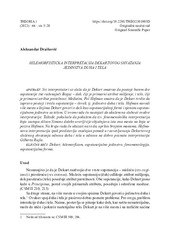Hilemorfistička interpretacija Dekartovog shvatanja jedinstva duha i tela
Hylomorphic Interpretation of Descartes’s Notion of the Union of Mind and Body
| dc.creator | Drašković, Aleksandar | |
| dc.date.accessioned | 2023-10-20T09:35:07Z | |
| dc.date.available | 2023-10-20T09:35:07Z | |
| dc.date.issued | 2023 | |
| dc.identifier.issn | 2683-3867 | |
| dc.identifier.uri | http://reff.f.bg.ac.rs/handle/123456789/5044 | |
| dc.description.abstract | Svi interpretatori se slažu da je Dekart smatrao da postoje barem dve supstancije (ne računajući Boga) – duh, čiji je primarni atribut mišljenje, i telo, čiji je primarni atribut protežnost. Međutim, Pol Hofman smatra da je Dekart tvrdio da zapravo postoji i treća supstancija – čovek, tj. jedinstvo duha i tela. Hofman navodi više mesta u kojima Dekart govori o duši kao supstancijalnoj formi i njenom supstancijalnom jedinstvu sa telom. U ovom radu ću nastojati da ukažem na slabosti ovakve interpretacije. Takođe, pokušaću da pokažem da tzv. fenomenološka interpretacija koju zastupa Alison Simons daleko uverljivije objašnjava ista ona mesta na koja se poziva Hofman. Na kraju rada ću ukazati na to da, uprkos brojnim manama, Hofmanova interpretacija ipak predstavlja značajan pomak u rasvetljavanju Dekartovog složenog shvatanja odnosa duha i tela u odnosu na dobro poznatu interpretaciju Gilberta Rajla. | sr |
| dc.description.abstract | All interpreters agree that Descartes thought that there are at least two substances (excluding God): mind, whose primary attribute is thought and body, whose primary attribute is extension. However, Paul Hoffman argues that Descartes thought that there is in fact a third substance – a human being, namely a substantial union of mind and body. Hoffman refers to many passages in which Descartes describes the soul as the substantial form and its substantial unity with the body. In this paper, I will try to point out the weaknesses of this interpretation. Also, my aim is to show that the phenomenological interpretation by Alison Simmons provides a much more convincing explanation of the same passages that Hoffman refers to. Finally, I will show that, despite many of its flaws, Hoffman’s interpretation still represents a significant improvement in illuminating Descartes’s complex understanding of the mind-body relation, relative to the well-known Gilbert Ryle’s interpretation of Descartes. | sr |
| dc.language.iso | sr | sr |
| dc.publisher | Srpsko filozofsko društvo | sr |
| dc.rights | openAccess | sr |
| dc.rights.uri | https://creativecommons.org/licenses/by/4.0/ | |
| dc.source | Theoria | sr |
| dc.subject | Dekart | sr |
| dc.subject | hilemorfizam | sr |
| dc.subject | supstancijalno jedinstvo | sr |
| dc.subject | fenomenologija | sr |
| dc.subject | supstancijalna forma | sr |
| dc.subject | Descartes | sr |
| dc.subject | hylomorphism | sr |
| dc.subject | substantial union | sr |
| dc.subject | phenomenology | sr |
| dc.subject | substantial form | sr |
| dc.title | Hilemorfistička interpretacija Dekartovog shvatanja jedinstva duha i tela | sr |
| dc.title | Hylomorphic Interpretation of Descartes’s Notion of the Union of Mind and Body | sr |
| dc.type | article | sr |
| dc.rights.license | BY | sr |
| dc.citation.epage | 20 | |
| dc.citation.issue | 1 | |
| dc.citation.spage | 5 | |
| dc.citation.volume | 66 | |
| dc.identifier.doi | 10.2298/THEO2301005D | |
| dc.identifier.fulltext | http://reff.f.bg.ac.rs/bitstream/id/12441/0351-22742301005D.pdf | |
| dc.type.version | publishedVersion | sr |

